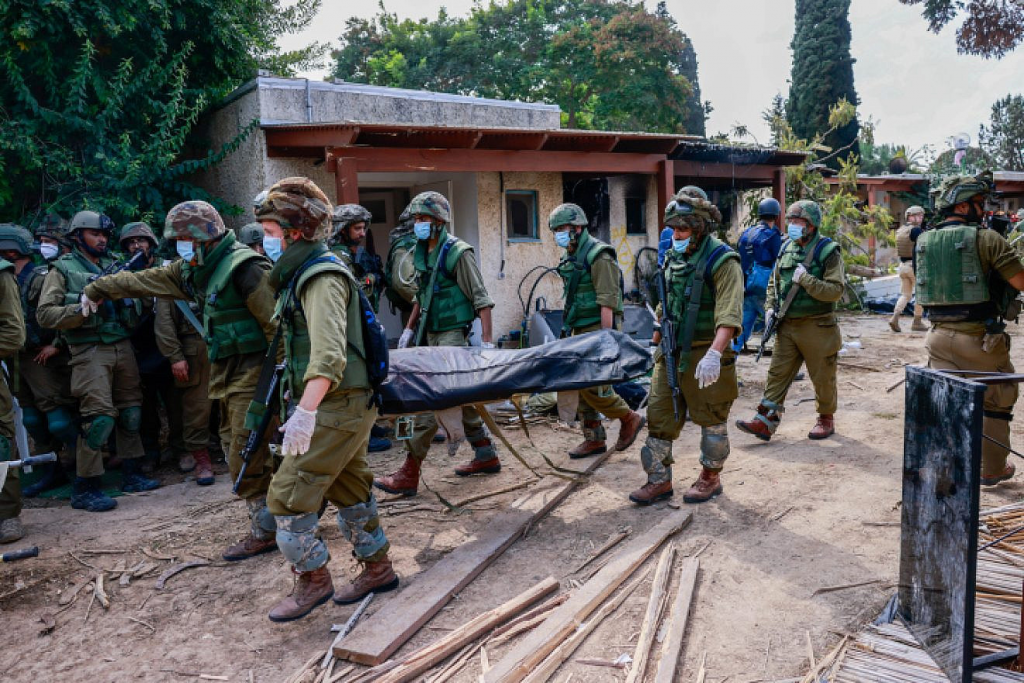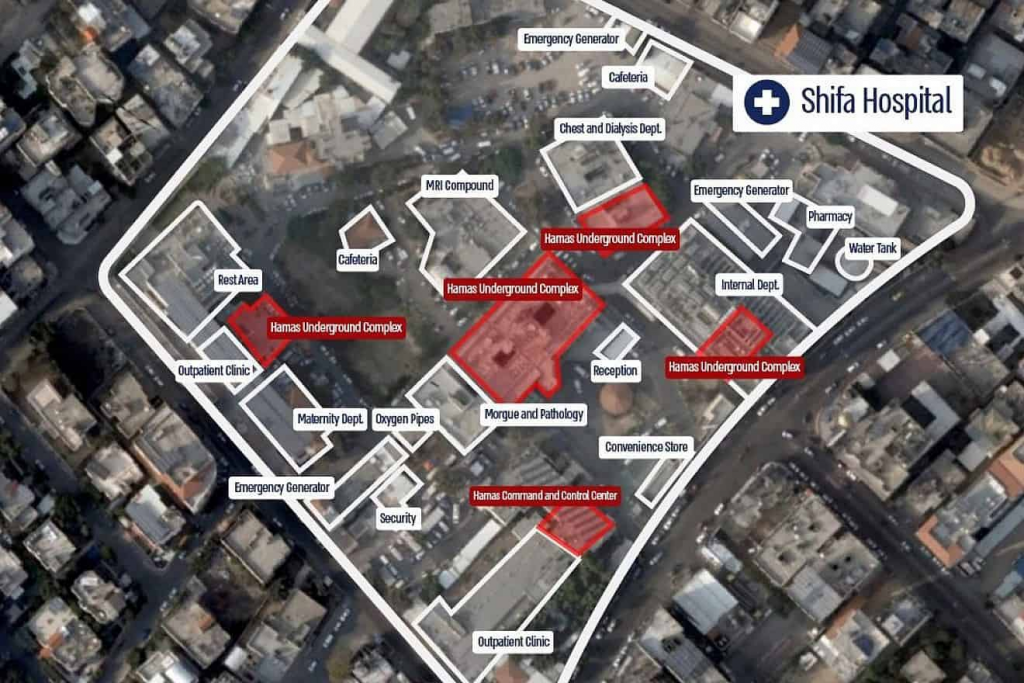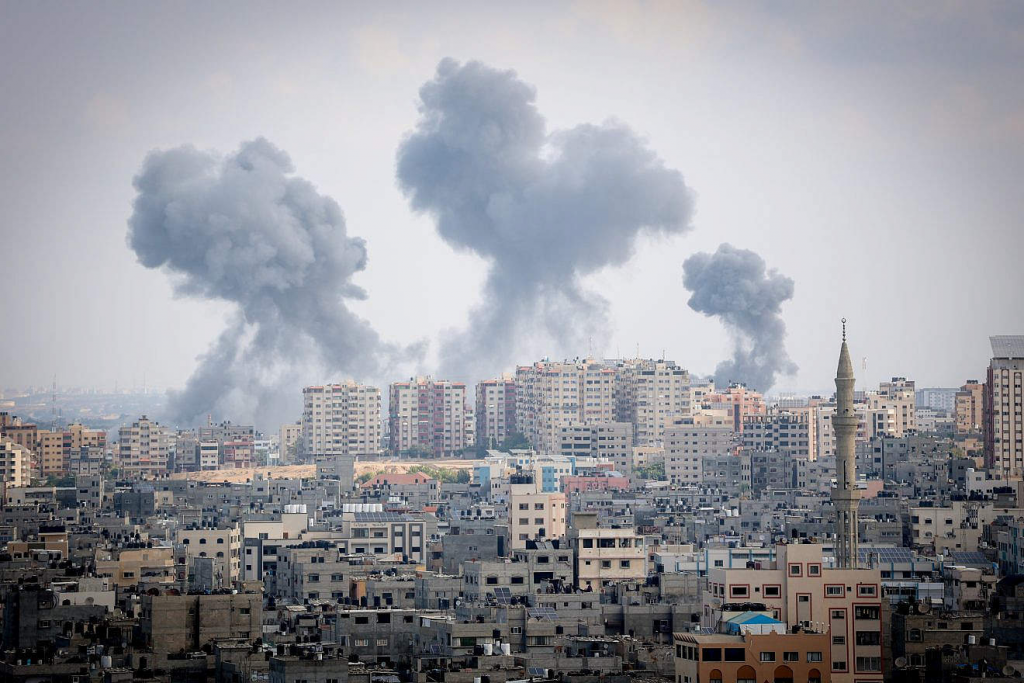
JERUSALEM (JNS) – The Israel Defense Forces ground offensive is intensifying and expanding, the military announced on Sunday night.
Ground forces, the Israel Air Force and Navy operated in Gaza and killed tens of terrorists in recent hours, IDF Spokesperson Rear Adm. Daniel Hagari stated.
Many of the killed terrorists were tactical commanders who orchestrated Hamas squads on the ground, according to Hagari. The IAF is continuing with massive airstrikes to defend the ground forces and destroy the Hamas terror infrastructure.
Also on Sunday, Hamas repeatedly targeted central Israel with intensive rocket barrages.
“In recent weeks we proved that Hamas is using civilians in Gaza cynically and is committing crimes against humanity,” said Hagari, particularly in its use of hospitals, schools, and other humanitarian sites.
The Palestinian population is saying that Hamas chief in Gaza Yahya Sinwar “doesn’t care about them,” said Hagari, except to use them as a human shield.
“Sinwar brought disaster to Gaza, he lost control, and he is the one responsible for Gaza’s collapse. He thinks and acts like a murderer and proved to the whole world that Hamas is worse than ISIS when he committed the murderous attack on October 7,” said Hagari.
“We will pursue Yahya Sinwar until we reach him,” he added.
In the North, a number of projectiles were launched from Lebanon at Israel, prompting return IDF fire, as well as strikes on the Hezbollah terrorist infrastructure, said Hagari. The IDF also struck three terror squads in Lebanon who tried to infiltrate Israel. Sirens also went off at Kiryat Shmona.
In response to fire from Lebanon towards the northern border, “during the night we struck military targets, infrastructure and posts belonging to the Hezbollah terrorist organization,” he stated, adding, “the Hezbollah terrorist organization continues to operate against us in the north and we are striking all those who are acting against us. Any Hezbollah terrorist cell that comes near the fence will be hit.”
Overnight on Sunday, an IDF officer was severely injured by an enemy mortar shell in the northern Gaza Strip while engaging terrorists, while a second soldier sustained moderate injuries. Both have been evacuated to hospital, the military announced.
“We are progressing through the stages of the war according to plan. We are gradually expanding ground activity and the scope of our forces in the Gaza Strip,” Hagari said on Sunday morning.
“The operations on the ground are complex and include risks to our forces. We will do everything we can from the air, sea and land to ensure the safety of our forces and achieve the goals of the war,” Hagari added.
The IDF has so far notified the families of 311 fallen IDF soldiers and the families of 239 hostages.
The IDF also inducted a new course of field observers into service on Sunday, weeks after many such soldiers were killed during the surprise attack of Oct. 7.
“Observation soldiers play a very significant and important role in maintaining the security of Israeli civilians. They are deployed in defending all the country’s borders,” said Hagari.
“In the coming month, we intend to continue the November enlistment as usual, including the enlistment of combat soldiers. We will make the necessary adjustments so that all enlistments take place as planned, and that the building of the IDF’s strength will continue even in the shadow of the war,” he added.
In addition to Hamas terrorists, he said, residents of Gaza “murdered, slaughtered, raped tortured, and burned our citizens. They also invaded the Gaza Coordination and Liaison Office, our base, and murdered three of our soldiers. They did shocking things there that are difficult for me to say,” he said.
“Thousands of Palestinians passed through Erez Crossing every day to enter Israel for medical treatment and more. Our soldiers are the ones who provided the entry permits for them to enter Israel. A few days ago, I sat with the father of one of the soldiers who was murdered. He asked me if my son’s job was to help people with medical assistance, why did they murder him? I didn’t know what to tell him. This is Hamas.”

Hamas’s strategy has an operational component and a civilian component, said Goren. “As far as Hamas is concerned, the civilians in Gaza are a means to an end. Externally, they are trying to portray a humanitarian crisis to curtail the way the IDF uses its forces, and on the other hand they continue to operate the [Hamas] military system that emphasizes underground terror tunnels, next to medical sites that provide health services to Gaza.”
COGAT has assembled a team of experts that assesses the humanitarian situation in Gaza, and monitors what is in stock and what is missing, said Goren. “We interface every day with international organizations that operate on the ground in Gaza and with their headquarters. Even now, in the next room, I have my officers liaising with all the aid agencies to assess the situation,” he added.
There is no food shortage in Gaza, Goren said, adding that there is enough food for weeks to come. Ninety percent of Gaza’s drinking water is self-sourced, with only 10% coming from Israel via three water supply lines. “During the Hamas-ISIS massacre, they hit a water line that supplies Gaza. In recent days we opened two lines, and yesterday we delivered 28.5 million liters of water to Gaza,” Goren said.
While water accessibility is limited, there is enough water in Gaza for all civilians to arrive and pick it up from various access points, he added. “In the south [of Gaza] there is no problem, there is full accessibility and in northern Gaza there are several areas where it is a little difficult but there is enough water and medical equipment there,” he stated.
Hamas is in full control of the distribution of medical equipment in Gaza, said Goren, choosing how much should go to hospitals and when.
Hamas hit nine power lines from Israel with rockets, which supplies more power to the Strip than the Gazan power plant does, according to Goren.
Every hospital in Gaza has its own solar-powered electricity system, and generators that run on local diesel tanks, he said. Diesel generators are located all over the Strip, all controlled by Hamas, which keeps large amounts of diesel fuel underground in its tunnels.
“Hospital administrators in Gaza have been shouting they only have diesel for 24 hours. Twenty-three days have passed and they are still operating because Hamas is supplying them with fuel. Hamas has an interest in keeping them running, since hospitals above the ground have become Hamas’s headquarters underground. The hospitals are operational military infrastructures, as we revealed on Friday regarding the Shifa Hospital,” said Goren.

“Hamas does not care about residents of Gaza, some of whom took part in the massacre. In the end we still do what we can to prevent harming civilians. We are not in a fight against the civilians of Gaza. Hamas… prevents them moving from northern Gaza to the south–they prefer them as human shields in shelters and hospitals,” said Goren.
“During the Oct. 7 attack, Hamas caused significant damage to the Erez Crossing that allows movement of patients and workers to Israel. On the eve of war, Israel allowed 18,000 workers into Gaza earning 7,000 shekels [a month] instead of less than 2,000 shekels [in Gaza], where the unemployment rate was 47%. In 2022, 82,000 trucks and 22 million tons of goods entered Gaza via the Erez Crossing. You can look at GDP numbers and see an enormous increase that is the byproduct of Israeli policy,” Goren said.
Meanwhile, Israel is facilitating a U.S.-Egyptian-U.N. mechanism for sending in goods via the Rafah Crossing from Egypt. The trucks first enter Israel’s Nitzana Crossing for security inspection, then continue on to Rafah for distribution.
COGAT will monitor the humanitarian situation, but Israel and the IDF continue to fight against terrorism, protect Israelis and work to “bring back our people who have been kidnapped and are being held inside Gaza,” Goren stressed.
On Sunday, the Wall Street Journal cited a senior U.S. official as saying that Israel had taken steps to shut down Gaza’s phone and internet communications, but that the U.S. convinced Israel to reverse those measures.
“The restoration of some telecommunication services on Sunday morning meant that the U.N., WHO and other emergency and aid groups could begin to coordinate with their staff in Gaza again,” said the report. “The official said that the U.S. made it clear to Israel that communications needed to be turned back on,” it added.
Meanwhile, the Israel Air Force struck over 450 terror targets from Saturday morning to Sunday morning. Targets included operational command centers, observation posts, and anti-tank missile launch posts.
“As part of the expansion of ground activities, combined combat forces struck terrorist cells that attempted to attack the forces and terrorist cells that planned to carry out anti-tank missile launches. In addition, the ground forces directed IDF aircraft toward terror targets,” said the military.

On Saturday evening, Hagari, confirmed that the military pressure by the IDF against Hamas is also intended to bring all of the hostages home.
“Hamas committed an atrocious massacre, and is currently holding hostages. This is a crime against the whole of humanity, and the entire world should join the call to release all of the hostages. All of them,” said Hagari.
Addressing the North, Hagari said that on Saturday morning, “We intercepted a surface-to-air missile that was fired at an IDF UAV; and also targeted terrorist cells that fired at IDF forces. All sources of fire were targeted by the IDF and we also struck additional Hezbollah targets. We continue to remain at a high level of preparedness in the North and ready for any scenario.”
In Judea and Samaria, the IDF and the Shin Bet security agency are carrying out a broad counter-terrorism operation, and have arrested over 600 Hamas gunmen since Oct. 7, said Hagari.
Alerts for terror attacks, most of which are being thwarted by the IDF and the Shin Bet, remain in place, said Hagari, adding, “I am asking the public to be vigilant at this time.”
As reported by VINnews
